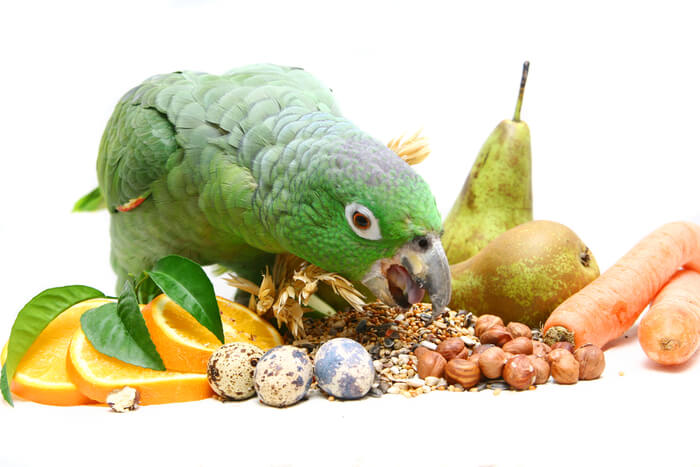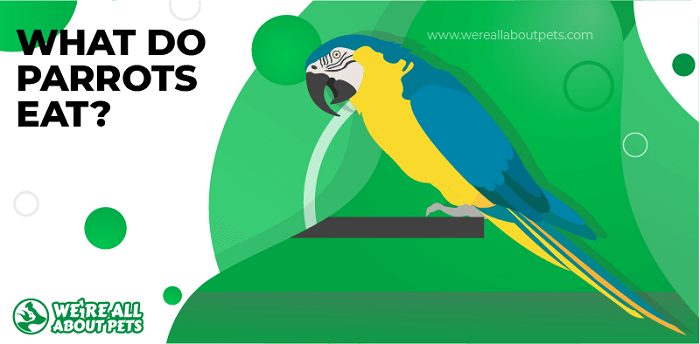Amazon Parrot: Lifespan, Care & Cost (A Complete Guide)
This page contains affiliate links. We may earn money or products from the companies mentioned in this post through our independently chosen links, which earn us a commission. Learn More

The term ‘Amazon Parrot’ is actually used to describe several different types of parrot – in fact, over thirty different species. They all hail originally from the Amazon region, and ten of these species have become fairly popular pets.
Amazon parrots are all fairly large (up to 20 inches in length), and require plenty of exercise and space. Intelligent, playful and friendly, they can bring a lot to a party! With a lifespan of around fifty years, they are a big commitment to take on.
Some of the species are known to be good at talking, and need careful attention and training so as not to become obnoxiously noisy!
Amazon Parrot lifespan
The Avg. Amazon Parrot lifespan is 25-50 years, some Amazon Parrots have been reported to leave for as much as 65 years in captivity.
Personality And Temperament
Amazon parrots are athletic, curious and playful. They love being the centre of attention and need lots of time interacting with their owners. They can be affectionate and funny, with many enjoying being hand-fed and showing off with tricks and clown-ish antics.
Typically, Amazons go through a ‘bluffing’ stage as they reach sexual maturity, between 4 – 12 months. This can be a difficult stage to navigate, especially for inexperienced owners. The hormonal changes associated with adolescence can result in these birds becoming moody and difficult to handle, perhaps even aggressive.
Male amazon parrots are especially well-known for this, sometimes displaying stereotypical ‘male’ behaviours, such as strutting and flashing their feathers. If this stage, which can last up to two years, is not correctly managed, these birds can become very difficult to handle. Find out more about bluffing behaviour here.
Care

Amazon parrots are fairly large, and need plenty of activity and stimulation. They require a large cage (over 24 inches by 36 inches, with at least 48 inches in height), with toys and swings provided. We did some research and shared some suggestions for parrot-friendly cages. They will also need a safe space to fly in to provide essential exercise.
Amazon parrots love toys, especially to chew and play with their feet, so may go through quite a lot of them in their lifetime, no matter how sturdy. These birds love to climb, so a climbing ladder, playing gym or similar will be very appreciated.
Bathing is a real treat for these birds, and also helps to keep their feathers clean and healthy. Providing a safe water space, such as a bird bath or a spray bottle will be a wonderful source of entertainment, as well as excellent for hygiene. Your parrot may even try to join you in the shower!
A love of food and some excellent persuasive skills to get more treats mean that obesity can be a common concern. Novice owners of amazon parrots can underestimate the amount of exercise these birds require to keep them healthy and in good body condition. Ideally, they need at least 3 hours of flying time outside the cage, as well as plenty of climbing and play opportunities within their normal environment.
These parrots are intelligent and social creatures. Lots of interaction with their owners is beneficial, and they will enjoy learning things like tricks, or learning different sounds to mimic. When alone, they need plenty of mental exercise, such as puzzle toys and feeders. These keep your parrot occupied and less likely to develop stress and boredom-related behaviours such as feather plucking.
What Can Amazon Parrots Eat?

In their original Amazonian home, these species of parrot would eat nuts, seeds, berries and fruit. As a pet, they are best fed a balanced, complete pellet food – about 1/3 to 1/2 cup daily. In our article on nutrition for parrots, you’ll find a more in-depth approach to choosing the most suitable diets for parrots.
This can be supplemented with fresh fruit and vegetables – also 1/3 to 1/2 cup daily. This amount is a guide only, and should be altered depending on the bird’s weight, condition and exercise levels.
Seeds and nuts are high in fat, and should only make up a small proportion of their diet (less than 10%). Amazon parrots are prone to obesity, so treats should be kept to a minimum and their weight and exercise levels carefully monitored. Puzzle feeders can help keep greedy birds occupied with their food for longer, and expend more energy to get at it.
Frequently Asked Questions
Is the Amazon Parrot a good pet?
Amazon parrots are active, sociable and intelligent birds. They can make super pets: friendly, chatty and affectionate. They are often referred to as the ‘life of the party’ birds, due to their boisterous antics! However, they can be difficult in their long adolescent stage, and require a lot of care so may not be suitable for novices or families with children.
How much are Amazon Parrots?
Amazon parrots are usually available from specialist avian sellers or parrot breeders. Due to their long lifespan, they are also often available for adoption due to previous owners being unable to care for them for their entire lives. If you choose to buy, make sure you choose a reputable breeder. You can expect to pay around $1000 for one of these birds.
Can Amazon Parrots talk?
Many of the species of Amazon parrot are known to be excellent talkers, and also gifted at mimicry. They love music and singing, and can be incredibly noisy!
Are Amazon parrots good for beginners?
Amazon parrots need plenty of space, exercise and mental stimulation to thrive, so anyone who takes on one of these birds needs to have done their research and know what they are getting into. They also have a long lifespan, so are quite a commitment. Older birds can be rescued, and may be more suitable for a beginner, but navigating the difficult ‘bluffing’ phase of adolescence is not recommended for novice bird owners.








